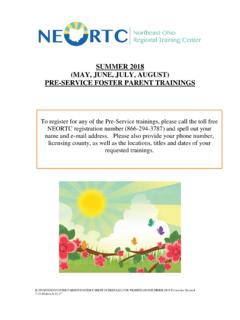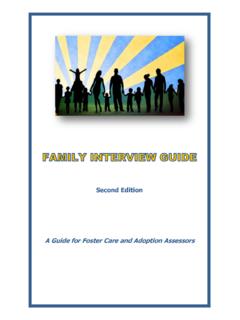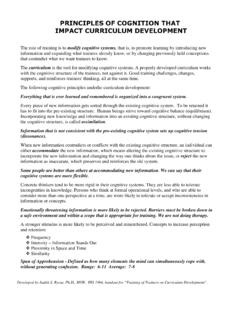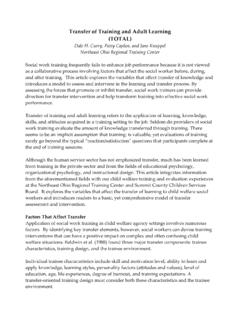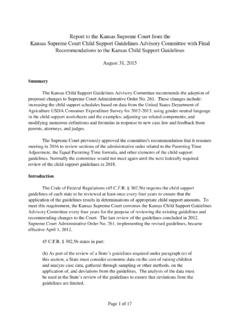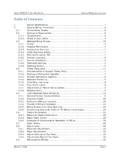Transcription of ProtectOHIO Kinship Strategy Manual Draft 12/7/2010
1 ProtectOHIO Kinship Strategy Manual Table of Contents ProtectOHIO Overview ..1 1. MISSION & Mission ..2 Purpose ..2 Core Components ..3 Relationship to Kinship Navigator Projects ..4 2. Kinship COORDINATION ..6 General Kinship Coordination Duties ..6 Kinship Coordination Training for Kinship Coordination Staff ..8 3. CASE MANAGEMENT .. 10 Kinship -Specific Safety & Needs Assessment .. 10 Assuring Safety of the Kinship Home .. 10 Needs Assessment .. 10 Written Support Plan .. 11 Support Plan Characteristics .. 11 Support Plan Content .. 12 Home Visits .. 12 Kinship Home Visit Protocol .. 13 Kinship Initiative Implementation Flow Chart .. 14 Handbook for Kinship Caregivers .. 16 Kinship & Family Team Meetings .. 17 Training for Kinship Caregivers .. 18 4. SERVICES AND SUPPORTS .. 20 Core services .. 20 Optional services .. 21 5. ADMINISTRATIVE SUPPORTS/ORGANIZATIONAL STRUCTURE.
2 23 Support within the PCSA .. 23 Locating, Identifying, and Assessing Kinship .. 23 Training for Workers .. 23 Regular Contact Among Kinship Coordinators .. 24 Court and Community Support .. 24 Ongoing Advocacy .. 24 Court Engagement .. 25 Data Collection .. 25 1 ProtectOHIO Overview In October 1997, Ohio implemented ProtectOHIO , a Title IV-E Child Welfare Waiver Demonstration project, under the authority of Section 1130 of the Social Security Act. Fourteen Ohio counties stepped forward to participate in the waiver, forming a ProtectOHIO consortium. Like other states with Title IV-E Waiver programs, Ohio and its Consortium counties were given the opportunity to use capped federal IV-E dollars, previously used for foster care reimbursement, to develop child welfare services and strategies. The primary goal of ProtectOHIO is to use the Title IVE waiver funds flexibly to change purchasing decisions and service utilization patterns to achieve better outcomes for children and families.
3 The focus for each of the 14 counties is to reduce the number of children coming into care, decrease the length of stay in care, decrease the number of placements experienced by children already in care, and increase the number of children reunited with their families or placed in other permanent situations. The first ProtectOHIO Waiver demonstration program operated for five years, from October 1, 1997 through September 30, 2002. A bridge period of two years followed, while the Ohio Department of Job and Family Services (ODJFS) negotiated with the federal Department of Health and Human Services (DHHS)/Children s Bureau to obtain a five-year extension. The extension was granted in January 2005, retroactive to October 1, 2004, and scheduled to end September 30, 2009. The new waiver expanded to include 18 counties, representing one-third of Ohio's child population. It featured a major shift in focus: the Consortium counties agreed to implement two or more specific interventions -- family team meetings plus at least one other Strategy from among supervised visitation, Kinship supports, enhanced mental health/substance abuse services, and managed care1.
4 ProtectOHIO Consortium Counties Ashtabula Franklin Medina Belmont Greene Muskingum Clark Hamilton Portage Coshocton Hardin Richland Crawford Highland Stark Fairfield Lorain Vinton In February 2009, Ohio formally requested another five-year extension of the waiver2. DHHS granted a series of short-term extensions to allow for full consideration of the extension request in the context of findings from the Human Services Research Institute (HSRI) evaluation report and the amended federal terms and conditions. In March 2011, the extension request was approved for an additional five years, from October 1, 2010 through September 30, 2015. The continued use of the Title IV-E funds will be used to strengthen the intervention strategies of Family Team Meetings and Kinship Support Services, with the intent to improve permanency outcomes for children in out-of-home placement and decrease use of foster care. 1 Kimmich, et al (2010).
5 Evaluation of the Second Ohio Title IV-E Waiver Demonstration Project: Comprehensive Final Report. 2 Colbert, Michael, March 8, 2011. Personal letter to Senator Max Baucus & Honorable Members of the United State Senate Committee on Finance. 2 ProtectOHIO Kinship Strategy Manual 1. MISSION & PURPOSE Mission The mission of the Kinship Strategy is to promote Kinship placement as best practice, increasing attention to and support for Kinship placements, caregivers, and families. Purpose The use of Kinship caregivers for placement of children at risk of out of home care is the preferred practice in child welfare and is promoted through federal and state legislation. For the purposes of the ProtectOHIO Kinship Strategy : Kinship caregivers ( Kinship ) are defined as relatives and non-relatives who have a connection (biological, familial, community, cultural, etc) to the child; Kinship placements consist of a span of time a child lives with Kinship caregivers while a case is open to ongoing services; and The term Kinship family is used to describe the Kinship caregiver(s), the children in their care, and others that reside in the home during a Kinship placement.
6 The search for Kinship caregivers should begin during the intake process and continue throughout the life of the case. This is expected even if placement is not needed at the time of initial agency involvement since one component of permanence is the development of a support system for the family. In addition to extended family, the search should include absent parents (including alleged fathers) and their families as possible placements in the event that one is needed. The primary purpose of placing a child with a suitable Kinship caregiver is to maintain a child s familial, cultural, and community ties, to enable a child to live in the least restrictive setting, and to provide safety and stability. In the long term, Kinship placements may be one of a range of positive permanency options. The purpose of the Kinship Strategy is to ensure that Kinship caregivers have the support they need to meet the child s physical, emotional, financial and basic needs.
7 Kinship caregivers should support and follow court orders, follow agency recommendations OAC 5101:2-1-01 Children services definitions of terms. "Kin" means the following: (a) Individuals related by blood or adoption: (i) Parents, grandparents, including grandparents with the prefix "great," "great-great," "grand," or "great-grand." (ii) Siblings. (iii) Aunts, uncles, nephews, and nieces, including such relative with the prefix "great," "great-great," or "great-grand." (iv) Cousins and first cousins once removed. (b) Stepparents and stepsiblings. (c) Spouses and former spouses of individuals named in paragraph (B)(129)(a) of this rule. (d) Any non-relative adult the current custodial caretaker or child identifies as having a familiar and long-standing relationship/bond with the child and/or the family which will ensure the child's social ties. 3 regarding reunification and visitation efforts with the child s biological parents/caregivers, and keep the child safe.
8 It is essential that Kinship caregivers are supported in order to connect with appropriate community resources (including financial resources) for the sake of maintaining placement stability. Core Components This section summarizes the main components of the Kinship Strategy discussed in detail in the remaining sections of this Manual . The ProtectOHIO Kinship Strategy focuses on all children with PCSA cases that are open to ongoing services in a ProtectOHIO demonstration county, regardless of custody status or supervision orders. Kinship Coordinators with knowledge regarding best practices in supporting Kinship families serve as experts on Kinship support practice within the PCSAs. These coordinators need not be solely dedicated to Kinship work; Kinship coordination functions may be assigned to the Coordinator and/or other PCSA staff as needed. See Section 2 for more information. Standard practices for location and identification of Kinship are employed by the PCSA and supported by the Kinship Coordinator and/or PCSA administrators and supervisors.
9 Diligent search efforts are a priority in this Strategy and are necessary to improve positive trends toward increased use of Kinship for placement. See Section for more information. Kinship -specific assessment tools and processes are used to ensure that Kinship caregivers can support the child in their care, and that services and supports they receive are aligned with their needs. See Section for more information. A Kinship Home Assessment Tool is completed; part 1 of this tool is used at the time of the initial placement and part 2 is used at the time a homestudy is completed, if a homestudy is necessary (or its contents incorporated into Kinship homestudies); part 1 and part 2 may be completed at the same time; and A Needs Assessment, a two-part tool, includes 1) Family Resource Scale, which is completed during the home assessment process; the Needs Assessment is repeated at least every 90 days in order to review changes in needs and family situations, and 2) a Services and Supports for Kinship Family Form.
10 A Support Plan is developed in accordance with the Kinship Home Assessment Tool and Needs Assessment results. This can be incorporated into the case plan or completed as a separate document according to legal protocol and policy with the county. Although the Support Plan has no standard format, it should be: individualized, based on needs assessment results, and reviewed, monitored, and updated regularly (every 90 days, in conjunction with review of the Needs Assessment). See Section for more information. Home visits with Kinship families occur at least monthly and include attention to the Kinship caregiver as well as the child and other family members. See Section for more information. The PCSA Kinship Handbook is provided to the Kinship caregiver when the youth is moved to a Kinship home, or at the time of the homestudy. See Section for more information. 4 Services are available to support Kinship families in accordance with their needs.
